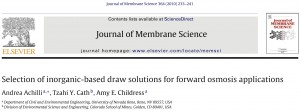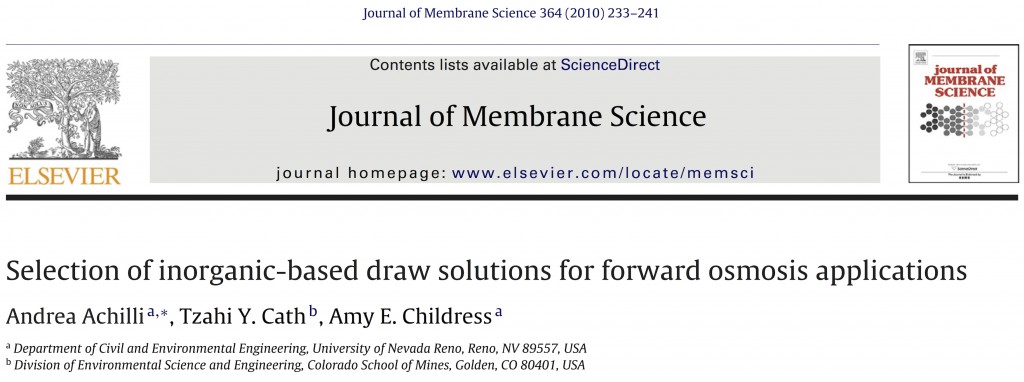- Nano-selective forward osmosis technology by SideStroem featured in Everything About Water - February 10, 2024
- SideStroem and Singapore Institute of Technology featured in AsianScientist - April 29, 2023
- SideStroem joins world class accelerator program - November 12, 2022
Why Achilli et. al. 2010 is a must read within the field of forward osmosis R&D
 In their article “Selection of inorganic-based draw solutions for forward osmosis applications” from 2010, Achilli and co workers screen more than 500 different inorganic compounds for their potential as draw solutes for forward osmosis applications.
In their article “Selection of inorganic-based draw solutions for forward osmosis applications” from 2010, Achilli and co workers screen more than 500 different inorganic compounds for their potential as draw solutes for forward osmosis applications.
An initial desktop screening removed all but 14 candidates through the following criteria:
- Must be water soluble
- Must be a solid at room temperature
- Must be non-hazardous
- Must have an osmotic pressure of more than 100 bar at saturation concentration
- Must cost less than 10 USD/L based on chemical unit prices from Fisher Scientific
The fact that Achilli et. al. base one of their selection criteria on unit prices from Fisher Scientific – and not bulk chemical prices from bulk supplier web portals such as Alibaba.com – is our only criticism of their work. It would be very interesting to see how the final draw solute selections change when bulk chemical prices are considered instead of costly R&D products.
Nevertheless, with their short list of 14 draw solute candidates in place, the researchers then proceed to rate each candidate by the following parameters:
- Forward osmosis water flux (based on a CTA forward osmosis membrane from Hydration Technology Innovations) – should be as high as possible
- The loss of draw solute from reverse salt flux during forward osmosis operation – should be as low as possible to minimize FO OPEX
- The loss of draw solute when re concentrating the draw solution after it has extracted feed water – should be as low as possible to minimize FO OPEX
- The propensity of the cation/anion component of the draw solute to cause mineral salt scaling inside the membrane and on the membrane surface – thus irreversibly reducing membrane performance – when diffusing into real-life feed streams containing mineral salt scaling counterparts – mineral salt scaling should be avoided in as wide a range of feed streams as possible
The final conclusion in the article is that there is no preferred draw solute that is universally applicable to all water treatment applications. However, for water and waste water applications (where many mineral salt scaling counterparts are present), MgCl2 is the best choice due to its low scaling propensity and good FO performance potential. And for applications with pure feed streams (e.g. food processing), KHCO3 and NaHCO3 are good choices because of their ability to deliver high water fluxes in combination with low reverse salt fluxes.
We regard the work of Achili and co-workers as a must read for anyone wanting solid background material on which to base their choice of draw solute. Additionally, Achilli et. al. 2010 has been cited 105 times since publishing – according to Google Scholar, February 2014 – which confirms the article’s place among the most influential recently published forward osmosis literature.


Hi ForwardOsmosisTech
It was a great pleasure reading your review of Achilli et. al. 2006. I’m sure you agree with me that draw solution selection is an integral part of designing FO systems for real life applications. The scientific field of forward osmosis draw solutions is well developed, and I have read several articles suggesting various polymers, thermolytic salts, and even magnetic nanoparticles as draw solutes. I would love to hear your opinion on the different draw solutes descibed in litterature. Which one do you believe the most in?
Keep up the good work – I look forward to reading more about forward osmosis technologies on your site in the future
Steven
Hi Steven
First of all thank you very much for your kind words about our site. And yes, we totally agree with you that draw solution selection is an key aspect of implementing FO systems in real-life applications. As for the draw solutions you mentioned, here are our thoughts on them:
Polymer based draw solutions have the advantage of being easier (less energy intensive) to reconcentrate in the process of generating pure/potable water in hybrid FO processes as the reconcentration step can be accomplished using UF membranes. In addition, polymers can generate quite high osmotic pressures in solution. However, the diffusion coefficient for polymers in solution is considerably lower than for salts in general, which gives rise to a higher membrane K value and thus more severe concentration polarization effects. Finally, polymer solutions tend to be very viscous resulting in more energy being spent pumping the draw solution through the FO system.
Thermolytic salts are a good idea on paper. Draw solutions based on thermolytic salts can in principle be reconcentrated using waste heat, which eliminates the need for expensive membrane sub systems. However, since the thermolytic process requires gas to be collected and subsequently brought back into solution, a more complicated FO system design is required to avoid loss of thermolytic salt in the process. To our knowledge there are still several significant challenges to be solved before industrial FO system designs using thermolytic salts are a reality.
Magnetic nanoparticles are a cool research topic, but they will never work in real-life applications. The whole point of using FO is to save energy, but to reconcentrate a draw solution based on magnetic nanoparticles energy must be spent on magnetic fields. Not to mention the expectedly very low diffision coefficient for such particles.
Our opinion- here at ForwardOsmosisTech – is that the choice of draw solute critically depends on the application at hand. For wastewater treatment, inorganic salts, such as the ones described by Achilli et. al., are the best choice for draw solutions until alternative – low energy reconcentrate – draw solutes have been proven on industrial scale. For foodprocessing applications a reverse flux of inorganic salts is unacceptable, and therefore polymerbased draw solutions seem to be a better choice.
The ForwardOsmosisTech team
I am interested in why you think using magnetic nanoparticles would never be possible in real life? Doesn’t reconcentrating other draw solutions such as thermolytic salts require energy as well? I think that the energy required to reconcentrate MNP’s would still be significantly less than whats required for RO desalination.
Hi Michael
First of all, thank you very much for your comment – it is great to get connected to other people who are interested in forward osmosis processes.
Regarding your question, you are absolutely right that reconcentrating other draw solutions (thermolytic salts, cloud-point polymers, regular inorganic salts, etc.) also requires energy. And to be honest, I haven’t done the energy consumption calculations for reconcentrating a draw solution based on magnetic nano particles. This would definitely be interesting to do.
My biggest problem with MNPs is their low diffusion coefficient compared to ions and expected high cost. In addition, there are most likely a lot of practical challenges that need solving from a forward osmosis system point of view, before a MNP system becomes functional.
I would love to hear your thoughts on MNPs – maybe I’m missing out on some key information.
Cheers
Ed